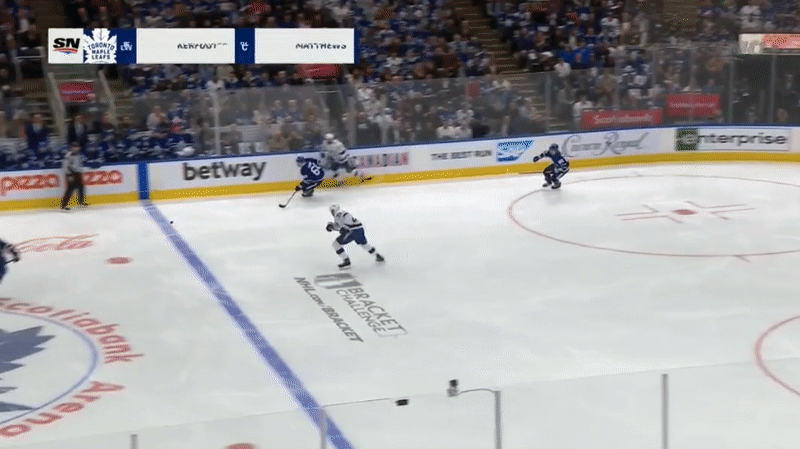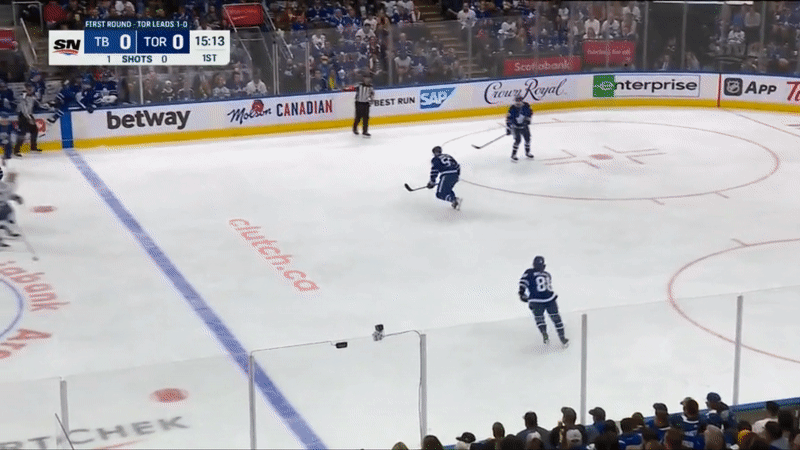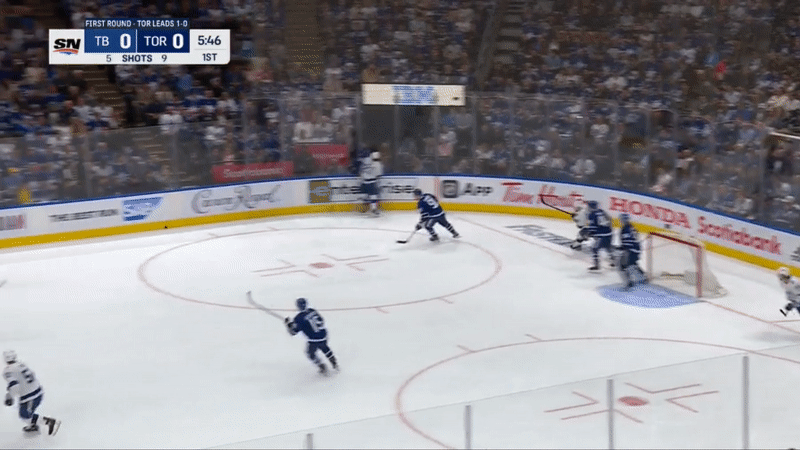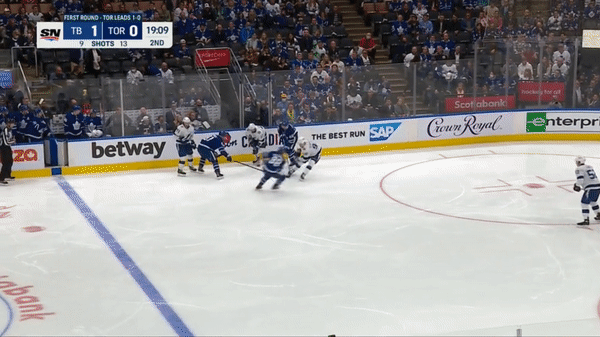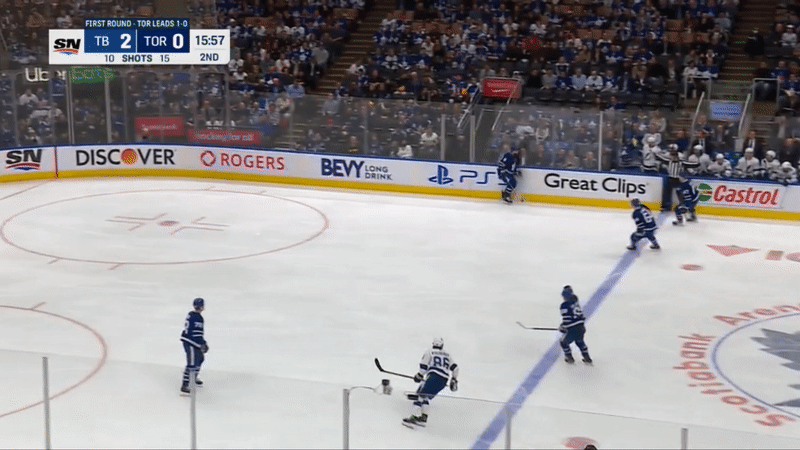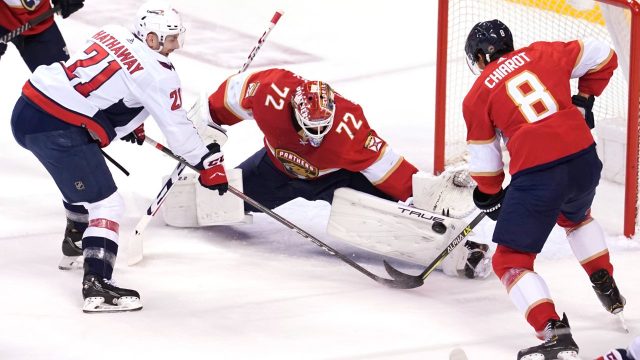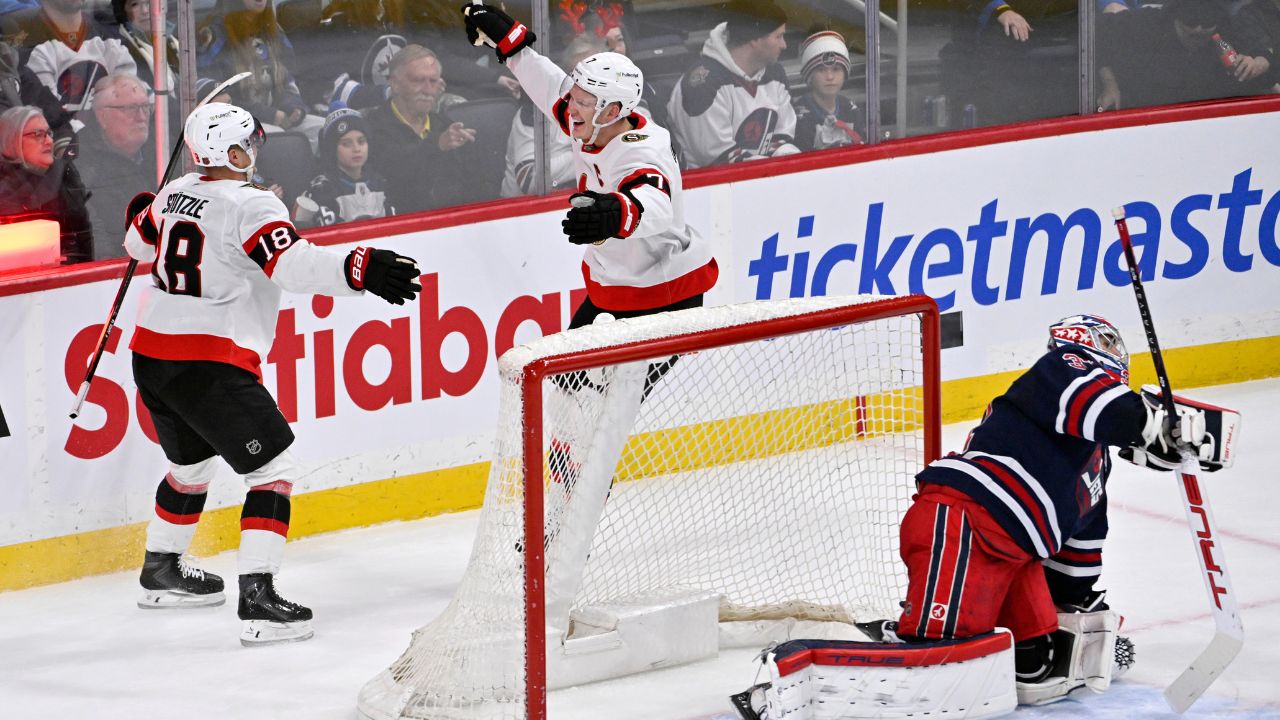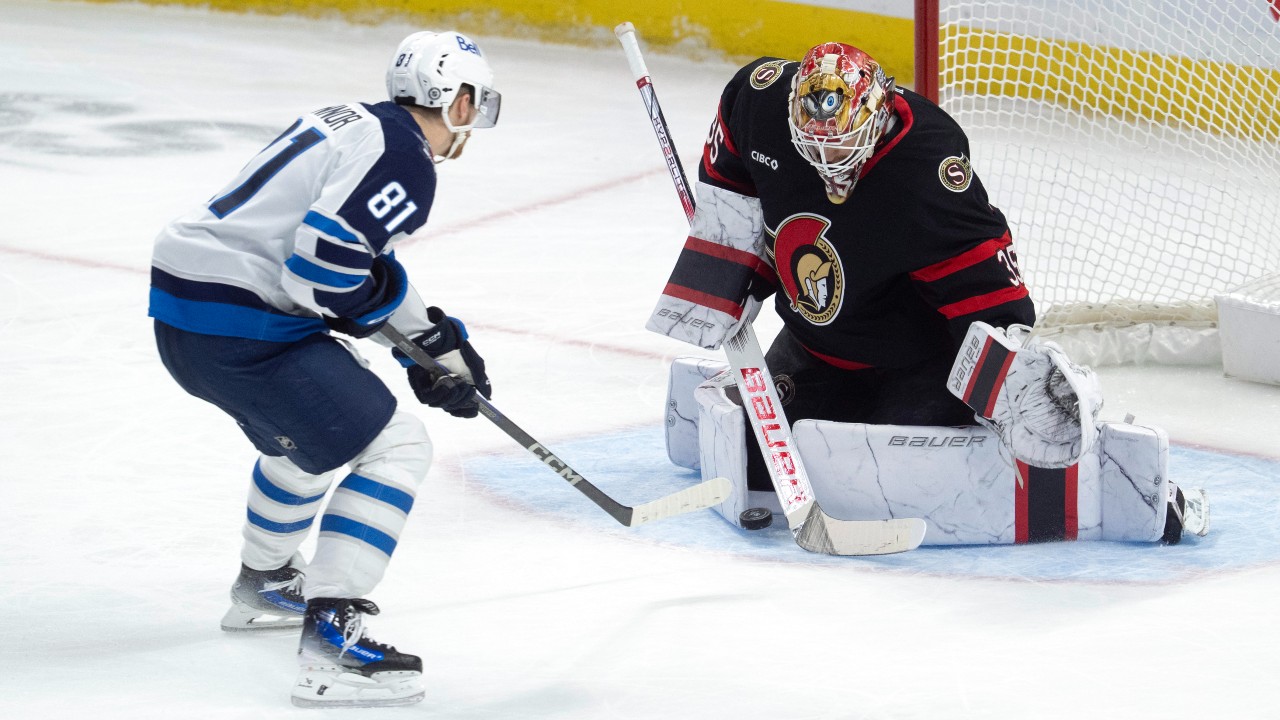
Through two games, the Toronto Maple Leafs’ first-round bout against the defending champions has been about as tumultuous as expected.
With Game 3 against the Lightning looming, the teams take a split into Amalie Arena, Toronto earning a dominant win in the first outing, Tampa Bay answering with a statement of their own in the sequel. The next meeting will be a telling one, the Maple Leafs intent on proving their mettle with a similar bounceback response, the Lightning looking to simply keep rolling now that they’re awake and engaged.
There’s no mystery involved in the diagnosis of where it all went wrong for the Leafs last time out. Playing a more disciplined game is priority No. 1 heading into Game 3. But there’s a greater shift Toronto needs as well – a return to the dynamic, high-octane, playing-with-pace game that got them to this point.
And the path that will lead them back to that style of play runs through the middle of their offensive group.
Of the eight goals Toronto has put past Andrei Vasilevskiy so far, five have come from members of the club’s top line – two each from Auston Matthews and Mitch Marner, one from the recently returned Michael Bunting. All told, the Leafs’ two biggest stars have dominated, even amid the wreckage of Game 2. It’s the other marquee scorers on the roster who the coaching staff need to get more involved if the club hopes to find the secondary scoring needed to survive the post-season.
And after the season he put together in 2021-22, William Nylander is next on that list.
It’s been an odd series for No. 88 so far. With the hefty number of penalties called through Games 1 and 2 leaving ice-times looking wacky throughout the lineup, Nylander’s averaging around two minutes less than he did during the regular season. And take out the minutes he’s getting on all those power plays, and it looks even more bizarre: in Game 1, he saw just 8:22 at even-strength, the fifth-least on the team. In Game 2, just 11:08, the sixth-least.
And yet, when Nylander has been on the ice, he’s had an impact. He’s used his feet to put in momentum-building shifts, establishing the Maple Leafs’ speed game, and used his vision to set up key looks from his teammates. The Maple Leafs faithful need no reminding of how effective the winger can be when it all lines up right. They need only look back to the team’s collapse against Montreal last season, when Nylander was the only Leaf who performed as he was expected to, putting up five goals and eight points (both team-leading) through the seven-game series.
“Will’s a guy who’s played real well in playoffs the whole course of his career,” teammate Jason Spezza said late last month, the night Nylander scored his career-high 32nd goal of the year. “We all know that when he’s on his game, he’s tough to stop.”
Coming into these playoffs riding high after finishing with career bests of 34 goals and 80 points – and rolling down the home stretch of the season with 30 points through his final 25 games – all eyes are on Nylander to come up with the type of performance he did last post-season. The problem is, so far, those flashes of impact have come between long stretches stuck on the bench while the team kills off penalty after penalty, or amid some inner chaos after eating suspect sushi.

But taking a closer look at what exactly he’s done so far, it seems the smooth-skating winger has plenty more to give, if the team can simply get him on the ice more. Part of that comes down to just playing more of the game at even-strength — something the officials aren’t making easy for either club, and something the Leafs made harder on themselves in Game 2. But penalty drama aside, there’s also the question of whether it’s become necessary to move No. 88 back into the top six.
First, let’s take stock of what Nylander’s shown so far through this series. The question with the enigmatic playmaker has always been whether or not he’s fully engaged – “When he’s going, he’s going, right?” – or whether he’s spending too much time waiting for the game to come to him. So far, he’s looked far more the former than the latter.
Going back and rewatching all 37 of Nylander’s shifts from Games 1 and 2, that’s plain to see. In Game 1, the winger admitted he lost steam over the latter half of the tilt – understandable given he was dealing with a rough bout of food poisoning and the Leafs had a comfortable lead sealed. Still, he was flying early – over his first 10 shifts of the game, six saw Nylander contributing positively for the Maple Leafs, using his feet or his vision to create something for his club.
It started right off the hop – on his first shift of the game, Nylander takes a pass from Pierre Engvall and steams into the Lightning’s zone down the right wing, setting the tone early and establishing the Maple Leafs’ speed game.
Then he sits for ages, playing once between that stretch of seven penalty-kill minutes. On his third shift of the game, he comes out on the power play with the momentum building off that five-minute major and gets a good look on net from the slot.
His next shift, he’s back to using his speed, picking up the puck off a turnover and flying back into the offensive zone – this time putting his shoulder down and driving for the net, drawing a penalty.
The very next shift, it’s more of the same. He steps up and blocks a shot, disrupts another pass attempt and then zips up ice for a breakaway chance.
His seventh and ninth shifts see some more good looks – deflecting a puck and jamming at a rebound on the man-advantage, and setting up Ondrej Kase for a chance later – before he loses steam over the latter half of the night.
Game 2 was, expectedly, a bit of a different bag. Still, of his 18 shifts – he technically had 21, but three were mere seconds long, before a whistle and a line change – 11 of them saw him have some type of positive impact for Toronto. Of course, coach Sheldon Keefe got the flipside of the coin too, with one awful shift from the winger in the middle of the game nearly setting the team back. But let’s take a look at the positives first:
On his third shift of the game, Nylander again looks to use his speed early, faking as if he’ll leave the puck to his defender in Toronto’s zone before curling and taking off down the right wing, carrying it all the way into the far corner of the Bolts’ end.
His next time over the boards comes on the man-advantage, where he gets a good look from the slot. The one after that, he puts together another quality sequence carrying the puck up ice, sidestepping a Bolt in the neutral zone and gaining the offensive zone.
Soon after, on his seventh shift of the game, he comes up big again, stealing the puck from Mikhail Sergachev along the wall and air-mailing it to Alex Kerfoot up ice – later on that same shift, he intercepts a pass from Sergachev, controls the puck behind the cage, and winds up with a great look from the top of the right circle.
One shift later, he’s setting up a good look from Morgan Rielly. A couple shifts after that, he comes up with one of Toronto’s key sequences of the game – it starts with Nylander fighting for the puck in the offensive zone, and ends with him setting up Mark Giordano and Timothy Liljegren for good looks on net, the latter one of the club’s best chances of the night, kept out only due to an all-world bit of goaltending.
Again, the very next shift, he’s back to subtly having an impact – tripped by Nikita Kucherov in his own zone, Nylander gets up and wires a stretch pass to Engvall’s tape at the far blue line, pushing the play up ice and back into the Bolts’ zone.
It’s midway through the night, on his 16th time over the boards, that it goes sideways. The shift starts with a tough turnover from Matthews as Nylander steps on the ice, forcing the winger to defend as Tampa rushes into the offensive zone. He fails to get in front of a Nick Paul shot, which ricochets off Jack Campbell and leaves a rebound that Brandon Hagel buries. It’s a killer of a goal, turning a fairly catchable 3-1 lead into a far more dicey 4-1.
Later on the same shift, with Nylander and the Leafs pressing, it gets worse, the winger tripping Pierre-Edouard Bellemare behind Tampa’s net, sending the opposition back to the power play after they’d already potted two on the man-advantage.
Luckily, he ends up getting bailed out by his penalty killers, Tampa’s power play stymied for the time being, and Nylander attempts to make up for the error by coming out of the box and flying down the right wing with the puck once again, nearly setting up Engvall and Kase for chances.
And then he’s back to quietly contributing.
On his 19th shift, he gets a shot off from the right circle, the attempt turned away by Vasilevskiy and the puck then iced by the Lightning under pressure. On the ensuing offensive-zone faceoff, Marner scores Toronto’s second of the night.
Nylander’s next shift sees him intercept a breakout pass in the neutral zone, pushing play back into the Bolts’ end and nearly setting up an Engvall look.
The winger’s next and final shift comprises the final 2:55 of the game, with the Leafs’ big guns all staying out to try to spur a late comeback. Nylander does his part decently enough, getting a one-timer off from the left side, ripping down the right wing to gain the zone entry, and getting another shot from that right side.
He sets up Tavares at the netfront, a chance that leads to a rebound Matthews nearly buries, and eventually setting up Matthews for a good look via a cross-ice pass whipped through the slot. All, of course, turned aside by Vasilevskiy.
He’s been far from perfect — the goose eggs on the scoresheet and that untimely chaotic shift in Game 2 evidence enough of that. But zoom out on No. 88’s play as a whole so far, and it’s clear he’s having an impact more often than not when he’s getting over the boards. And when he isn’t contributing positively, he’s most often going through sequences where little happens, rather than giving up a ton the other way, that lone subpar shift aside.
Looking ahead, it’s especially crucial that the Leafs get the rest of their scorers more involved in Games 3 and 4, as the series now shifts from their home turf to Amalie Arena. As Sportsnet colleague Luke Fox noted, that means Jon Cooper calling the shots on last change. The veteran bench boss is sure to throw his dominant shutdown line of Alex Killorn, Anthony Cirelli and Brayden Point at the Maple Leafs’ top trio, who mostly saw the Bolts’ Ondrej Palat-Steven Stamkos-Nikita Kucherov line through the opening pair of games.
Any dip in production from the Leafs’ two offensive pillars up top will spell trouble for Toronto, the pair comprising the bulk of the team’s offence so far.
Which means it’s all the more important that Keefe find a way to get Nylander over the boards more often given what he’s shown so far – whether that means giving some more ice to the Nylander-David Kampf-Engvall line if the club can enjoy a decent run of even-strength minutes this time around, or taking another crack at the Tavares-Nylander duo, or simply finding more spots to throw No. 88 out with one of the big guns for a lone shift.
Regardless of how they get there, there’s no way around the fact that the Maple Leafs need their middle six to break out the next time Toronto and Tampa Bay take the ice, because with the Bolts now comfortable, invested and heading back to their own house, the pressure’s set to ramp up even more on Toronto’s pack of leaders.
Just another reason to add a greater dose of Nylander into the Leafs’ gameplan on Friday, given his greatest internal attribute.
“He has a real strong belief in himself and his abilities,” Keefe said of the winger last month. “You know, at times he needs a push. But his belief in himself doesn’t waver.”




